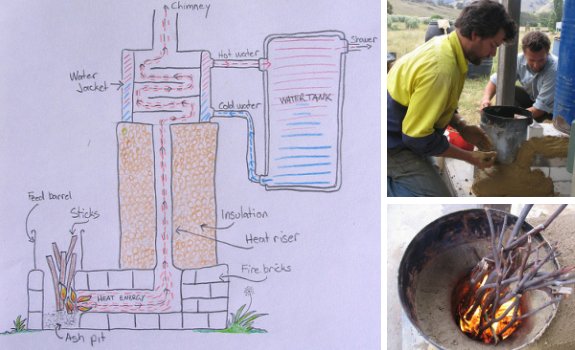
How to make a rocket stove shower

I appreciate all of the
alternative suggestions that readers have sent in concerning our solar
shower experiments and I especially liked the rocket stove shower
design by Milkwood.com
sent in by reader Sarah.
They built theirs in 2 days
and I'm guessing the cost to be around 200 to 400 dollars depending on
what type of materials you choose.
It's a bit complicated for
our current needs, but the idea has got me wondering if this could be
easily modified to handle some sort of hot water chicken dunking
station which might come in handy if the price of propane continues to
go up.
Want more in-depth information? Browse through our books.
Or explore more posts by date or by subject.
About us: Anna Hess and Mark Hamilton spent over a decade living self-sufficiently in the mountains of Virginia before moving north to start over from scratch in the foothills of Ohio. They've experimented with permaculture, no-till gardening, trailersteading, home-based microbusinesses and much more, writing about their adventures in both blogs and books.
Want to be notified when new comments are posted on this page? Click on the RSS button after you add a comment to subscribe to the comment feed, or simply check the box beside "email replies to me" while writing your comment.

After all these years I still use my old standby, a two quart copper kettle. Uses a minimum amount of fuel no matter what it is. I've used about everything I can think of. When I was on the boat I used a green hand pump pressure sprayer that sat in the sun all day. If it wasn't hot enough then the copper kettle fixed that. If I make it until next winter I hope to make a rocket stove heater. They are so efficient that I can heat my small space with sticks instead of logs. I live in the south but it still gets cold. When I was doing chickens I built a wood fire under a 50 gallon drum. It held enough water that the water stayed up to temperature until we were finished. Never did eat those chickens. Keep on Plucking.
The oldfool www.oldfool.org
For this design to work properly you need the water tank to be higher than the water jacket. Just like hot air, hot water rises.
The pipe returning the hot water to the tank should be vertical, well insulated and run to the top of the tank. The pipe from the tank to the jacket should come from the bottom of the tank.
In general, for thermosiphons you should use wide pipes to minimize resistance. It should also have as few bends and kinks as possible. A thermosiphon central heating I saw in an old (late 1920s) house used 2 inch pipes.
I notice your comment got tossed in moderation. Has the changeover to the new site made you unable to log in?
Great pointers on the design! You helped me understand it a lot more than when I read the original blog post about the design.
When I do a preview, I see my name under the post so AFAICT I'm logged in. Maybe a bug in the software?
The heater at milkwood has a little rise in the hot water tube, so it will work, but the "pump" will not be as efficient as it could be.
Another option for a water heater is to run pipes that transport the hot gases directly though the boiler. This is called a fire-tube boiler. An alternative is a water-tube boiler. Both have been thoroughly explored in the era of steam power. The latter are more suited for high-pressure steam generation because there is less water in the system to explode if the pressure gets too high. Both increase the contact area between the water and the hot gases, making for good heat transfer.
It seems to me that for just heating water a fire-tube boiler is easier to make; drill some holes in the top and bottom of the boiler, stick through some pipes and and weld them in place.